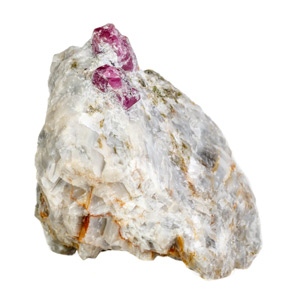corundum
Corundum, an illustrious gemstone species, derives its name from the Tamil word "kurundam," signifying a deep blue or sapphire. As one of the hardest minerals on Earth, corundum has earned its reputation for enduring beauty and remarkable durability.
Chemically composed of aluminium oxide, corundum is best known for its wide range of colours, including the fiery red of ruby and the serene blue of sapphire. These brilliant hues are a result of trace elements like chromium, iron, and titanium within its crystal structure.
Geologically, corundum typically forms in metamorphic and igneous rocks, while alluvial deposits can also yield gem-quality specimens. Notable sources include Burma (Myanmar), Sri Lanka, and Thailand.
Corundum boasts several remarkable attributes, including its status as the September birthstone and its association with qualities like love, courage, and protection in various cultures. Its presence in history, as both a treasured gem and a symbol of strength, continues to enchant gemstone aficionados and jewellery connoisseurs around the world.
Click on the terms in the table below to discover their meaning
Click on the terms in the table below to discover their meaning
| Name | Corundum |
|---|---|
| Category |
Oxide mineral |
| Chemical Formula | Al2O3 |
| IMA Symbol | Crn |
| Crystal System | Trigonal |
| Crystal Habit | Hexagonal, prismatic or steeply dipyramidal, tabular, rhombohedral, rarely acicular; also granular, massive |
| Twinning | Common lamellar (twinning planes); Contact or penetration twins rare |
| Cleavage | None |
| Fracture | Conchoidal to uneven |
| Tenacity | Brittle; tough when massive |
| Hardness (Moh's Scale) |
9 (defining mineral) |
| Specific Gravity | 3.98 - 4.10 |
| Diaphaneity | Transparent to translucent, may be opaque and display chatoyancy or asterism with oriented inclusions |
| Colour | Colourless, grey, brown, pink, to pigeon-blood red, orange, yellow, green, blue, to cornflower blue, violet; may be colour-zoned |
| Streak | White |
| Lustre | Adamantine to vitreous |
| Optical Class | Uniaxial (-) |
| Refractive index | nω = 1.767 - 1.772 |
| nϵ = 1.759 – 1.763 | |
| Birefringence | δ = 0.008 |
| Dispersion | Rd = 0.018 |
| Pleochroism | Weak; stronger when coloured |
| Clarity | Type II |
| Notable Varieties | Sapphire, Ruby |
References
Mineralogical Society of America. (2005). Corundum. In J. W. Anthony, R. A. Bideaux, K. W. Bladh, & M. C. Nichols (Eds.), Handbook of Mineralogy. Chantilly, VA 20151-1110, USA: Mineralogical Society of America. Retrieved from https://
The Gemology Project. (2006, December 22). Corundum. Retrieved from The Gemology Project: http://


